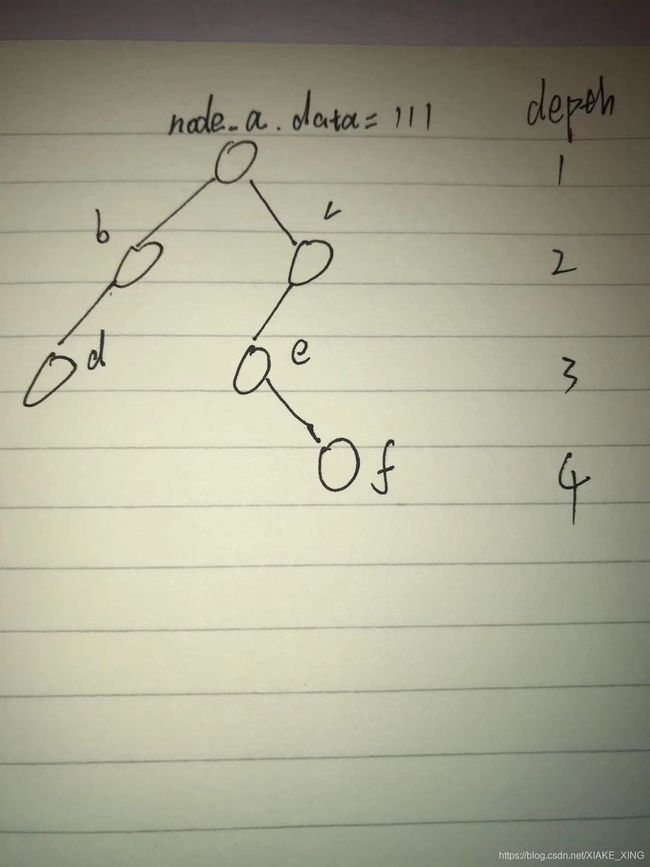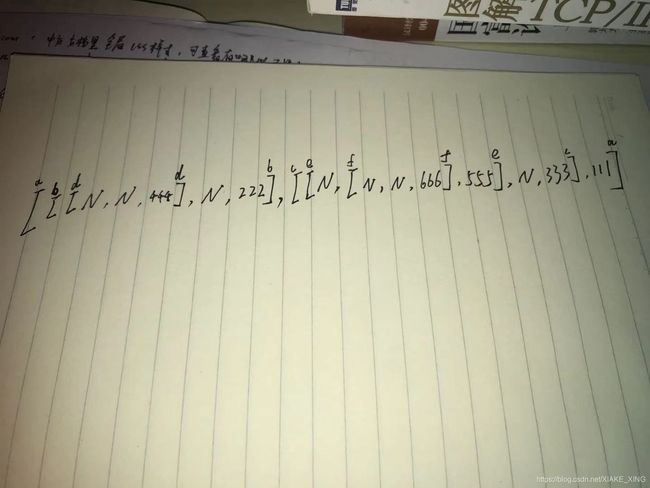二叉平衡树 python 列表 递归
二叉平衡树-python-列表-递归
用列表递归的方式表示二叉树,例如:只有根root的树用列表来表示就是 [None, None], 再例如一个这样的树:
用列表来表示就是:
[[None, None, 222], [None, [None, None, 444], 333], 111]
可以简单的认为看见一个 ‘ [ ] ’ 括号就认为它是一个节点,里面的元素有该节点的左kid,右kid,以及这个节点的data.
所以,我构建了一个这样的树结构:
class Node(object):
def __init__(self, data=None, l_kid=None, r_kid=None):
self.data = data
self.left = l_kid
self.right = r_kid
class Tree(object):
list_with_node = None # 例 :只有根的二叉树为 [None, None, root]
list_only = None # 例 :只有根的二叉树为 [None, None]
list_with_data = None # 例 :只有根的二叉树为 [None, None, root.data]
def __init__(self, root=None):
self.root = root
# 例:[None, None, root]表示一个只有root节点的树,有三个元素:左子树,右子树,该节点对象
def list_with_node_travel(self, node):
if not node:
return None
total = [
self.list_with_node_travel(node.left),
self.list_with_node_travel(node.right),
node,
]
return total
# 例:[None, None]表示一个只有root节点的树, [[None, None], [None, None]]表示一个第三层全为None的平衡树
def list_only_travel(self, node):
if not node:
return None
total = [
self.list_only_travel(node.left),
self.list_only_travel(node.right),
# node,
]
return total
# 例:[None, None, root.data]表示一个只有root节点的树,有三个元素:左子树,右子树,该节点的data
def list_with_data_travel(self, node):
if not node:
return None
total = [
self.list_with_data_travel(node.left),
self.list_with_data_travel(node.right),
node.data,
]
return total
def update_list(self):
Tree.list_with_node = self.list_with_node_travel(self.root)
Tree.list_only = self.list_only_travel(self.root)
Tree.list_with_data = self.list_with_data_travel(self.root)
# 层次遍历list,也可以说是树,当遇到第一个None时,返回None在该层的index,以及该层的深度depth
# depth从2开始,默认root存在, 换句话说Tree.list_only默认为list类型.
def _append(self, x, depth=2):
if isinstance(x, list):
if None in x:
# 返回该层第一次出现None的index和该层的depth
return x.index(None), depth
# 如果该层没有None,说明该层满了,那就用循环打开x内的所有list,并把他们拼在一起
# 这步的意思就是,进入下一层,递归判断第一次出现None的坐标
a = []
for i in x:
a.extend(i)
depth += 1
y = depth
return self._append(a, depth=y)
# 传入一个node,添加在树的结构里
def append(self, node):
index, depth = self._append(Tree.list_only)
code = self._arithmetic(index, depth)
if len(code) == 1:
# [None, None, node]为这个新node,左右子树为None, 节点对象为node.
Tree.list_with_node[int(code)] = [None, None, node]
# 为该node对象建立父子关系
if int(code) == 0:
self.root.left = node
else:
self.root.right = node
return self.update_list()
current_list = Tree.list_with_node
last = int(code[-1])
# 先走到这个新节点的父辈节点.
code_to_father = code[:-1]
for i in code_to_father:
current_list = current_list[int(i)]
# 此时current_list来到父节点[x, x, 父node],这时再看最后一步的方向来设置新node为父节点的哪边。
if last == 0:
current_list[-1].left = node
else:
current_list[-1].right = node
current_list[last] = [None, None, node]
return self.update_list()
# 根据depth和该层第一次出现None的index,得到一个神秘码(反映出该None在数中的坐标)
def _arithmetic(self, index, depth):
"""
这个算法建议画图琢磨
(position, depth),例如(6, 4)为第4层从左到右第6个元素。该层满元素个数为2 ** (depth - 1) = 8个
步数 = depth - 1 = 3 步
1. 因为6 > (8 / 2),所以从root开始找该元素时第一步是走root.right
2. 再用6 - (8 / 2) = 2, 因为 2 <= ((8 / 2) / 2),所以这步是走左边left,root.right.left
3. 上一步得出左边后,2就不用减((8 / 2) / 2), 因为2 > (((8 / 2) / 2) / 2),所以走右边right
4. 最后路线为:root.right.left.right总共走三步就到达该node准确位置
5. 神秘码就为 '101' , '1'为right, '0'为left. 遍历找node或node.data时会用到神秘码
"""
position = index + 1
# times为步数
times = depth - 1
# nums为该层满元素的个数(depth为2时,该层最多2个node,第三层最多4个node)
nums = 2 ** (depth - 1)
i = 1
code = ''
while i <= times:
if position <= nums / 2:
magic = '0'
nums = nums / 2
else:
magic = '1'
position = position - (nums / 2)
nums = nums / 2
code += magic
i += 1
return code
if __name__ == '__main__':
node_a = Node(data=111)
node_b = Node(data=222)
node_c = Node(data=333)
node_d = Node(data=444)
node_e = Node(data=555)
node_f = Node(data=666)
# 设置树关系
tree = Tree(node_a)
node_a.left = node_b
node_b.left = node_d
node_a.right = node_c
node_c.left = node_e
node_e.right = node_f
tree.update_list()
print(tree.__class__.list_with_data)
# 输出为: [[[None, None, 444], None, 222], [[None, [None, None, 666], 555], None, 333], 111]
此输出list描述的图,画出来后就是上述的图。
# append节点
add_1 = Node(data='add_1')
add_2 = Node(data='add_2')
add_3 = Node(data='add_3')
add_4 = Node(data='add_4')
add_5 = Node(data='add_5')
add_6 = Node(data='add_6')
add_7 = Node(data='add_7')
add_8 = Node(data='add_8')
add_9 = Node(data='add_9')
tree.append(add_1)
tree.append(add_2)
tree.append(add_3)
tree.append(add_4)
tree.append(add_5)
tree.append(add_6)
tree.append(add_7)
tree.append(add_8)
tree.append(add_9)
print(tree.__class__.list_with_data)
# 输出为:
[[[[None, None, 'add_3'], [None, None, 'add_4'], 444], [[None, None, 'add_5'], [None, None, 'add_6'], 'add_1'], 222], [[[None, None, 'add_7'], [None, None, 666], 555], [[None, None, 'add_8'], [None, None, 'add_9'], 'add_2'], 333], 111]
此结果所描绘的树结构就是上图所示的树结构。



